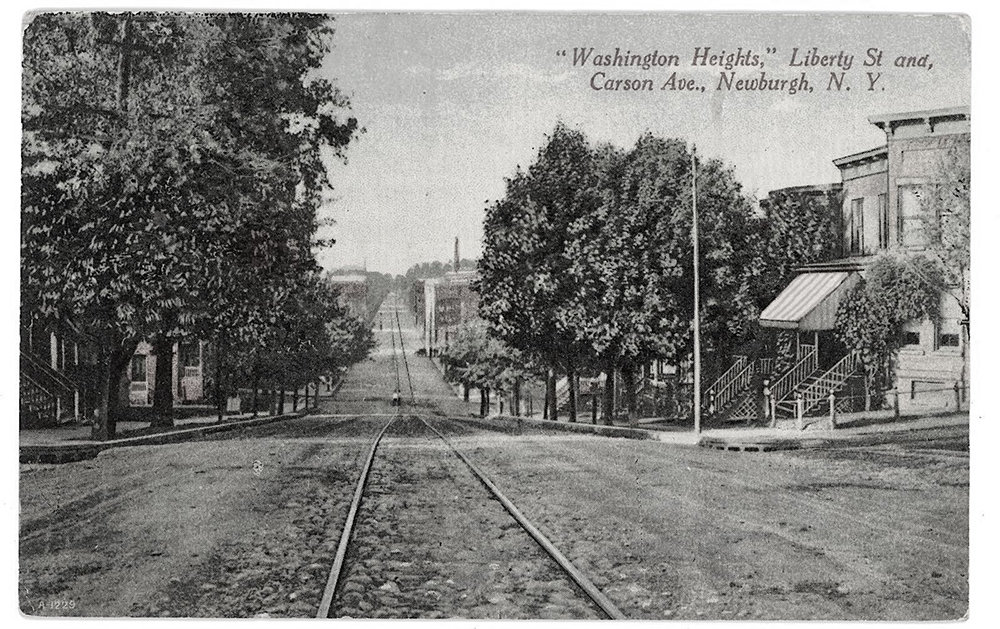
Looking from Carson Avenue, Liberty Street trolley tracks head north.
By Mary McTamaney
We have seen the upset and mess that Liberty Street business owners have been enduring while the blocks south of Broadway are being excavated and rebuilt throughout the summer and into fall. The barber, the stationer, the baker, the locksmith and the restaurateurs all testify to the customers they have lost and frustrated. It made me wonder what street excavation would be like if the contractors were faced with stopping not just automobile drivers but the train conductor too. Newburgh was a city with a street railway from 1886 to 1921 and trolley cars and their tracks spread around town, with Liberty Street being a core route taking riders from the south to the north city lines and beyond.
The street railway carried Newburghers to and from work and out for shopping and visits. Newburgh is only two by two miles in size, but those are long miles when you are carrying packages or have a deadline to meet. They are also hard miles to walk if you need to travel east and west on the city’s steep hillsides. Instead, people hopped aboard a streetcar to get to their jobs, including jobs all the way out in Balmville, if they cleaned or tended gardens or livestock for some of the grand estates. Throughout the network of street rail, they rode along carrying supplies and food to elderly relatives and friends. Parents boarded with their children to save forcing those little legs along the sidewalk for many blocks; plus, the kids loved the ride and the chance to see the city passing by. The generations before me told me often of the fun of “window shopping” from the comfort of a trolley seat and the delight of feeling the breeze in the open cars.
Our light rail system connected residential and business neighborhoods and connected as well with lines to surrounding communities. The main Newburgh trolley lines ran along Water Street, Broadway, Lander Street, Liberty Street and South Street. Dupont Avenue carried a spur out from Broadway to join Route 52/South Street. The Liberty Street route ran from Washington Heights on the south side of the city to the Balmville Tree in the Town of Newburgh. The Broadway route went all the way from the waterfront out past Orange Lake to Walden, NY. My dad was born on North Lander Street in an apartment in one of those beautiful mansard-roofed houses and told me about running out to the corner of South Street when he was a boy whenever he heard the trolley bells ring. The trolley driver never failed to ring his bells at that point because that was a passing zone. There was a small spur there on South Street, spreading two lengths of track just far enough apart not to let the trolley cars touch when they passed each other. Dad and his friends couldn’t believe that the giant (to their 6-year-old eyes) trolley cars wouldn’t crash and never failed to go watch the choreography of their switching tracks.
I grew up in the next era of frequent bus service around Newburgh and hopped on and off the “Northside” and “Southside” buses to do errands for my family and to visit school friends. My mother once told me about her morning commute on the Northside #6 bus which she rode down South Street to Liberty and to her job at the Newburgh Savings Bank. Newbugh’s mayor then was pharmacist Chester Brown who was also riding the bus to his drug store on Broadway. Mayor Brown loved his garden and, in season, he always picked a bunch of flowers as he left his yard on Robinson Avenue in the morning. He distributed these with a hearty “good morning” to each of his fellow bus passengers to brighten their lapels and their days. He understood marketing as well as neighborliness.
Trollies began as horse-drawn passenger cars. Then they converted to overhead electric cables as cities across America were doing. The owner of The Newburgh Electric Railway Company knew he could increase ridership even more if he provided a special destination for people to go on weekends and holidays. Lots of municipal trolley companies did so offering day trip “vacations” to people who could never afford a long trip away from home. Benjamin Odell created the Orange Lake Park which provided entertainments and water sports. Local author, Pat Favata, published a beautifully illustrated book fifteen years ago, Around Orange Lake, showcasing the variety of amusements that the park provided just fifteen minutes west of Newburgh on Route 52.
This year, another book about Orange Lake has been published. This time it is a novel and very intriguing. The Granddaughters by Margaret Belle unearths a mystery that changed the course of families who lived out at the lake. Both books are available online and at your local bookstore. How great it would be to sit on an old oak trolley seat heading west up Broadway and take a peek inside the covers of both books while we ride.
Maybe someday, we can watch street construction from the vantage point of a trolley seat in an era of modern light rail.